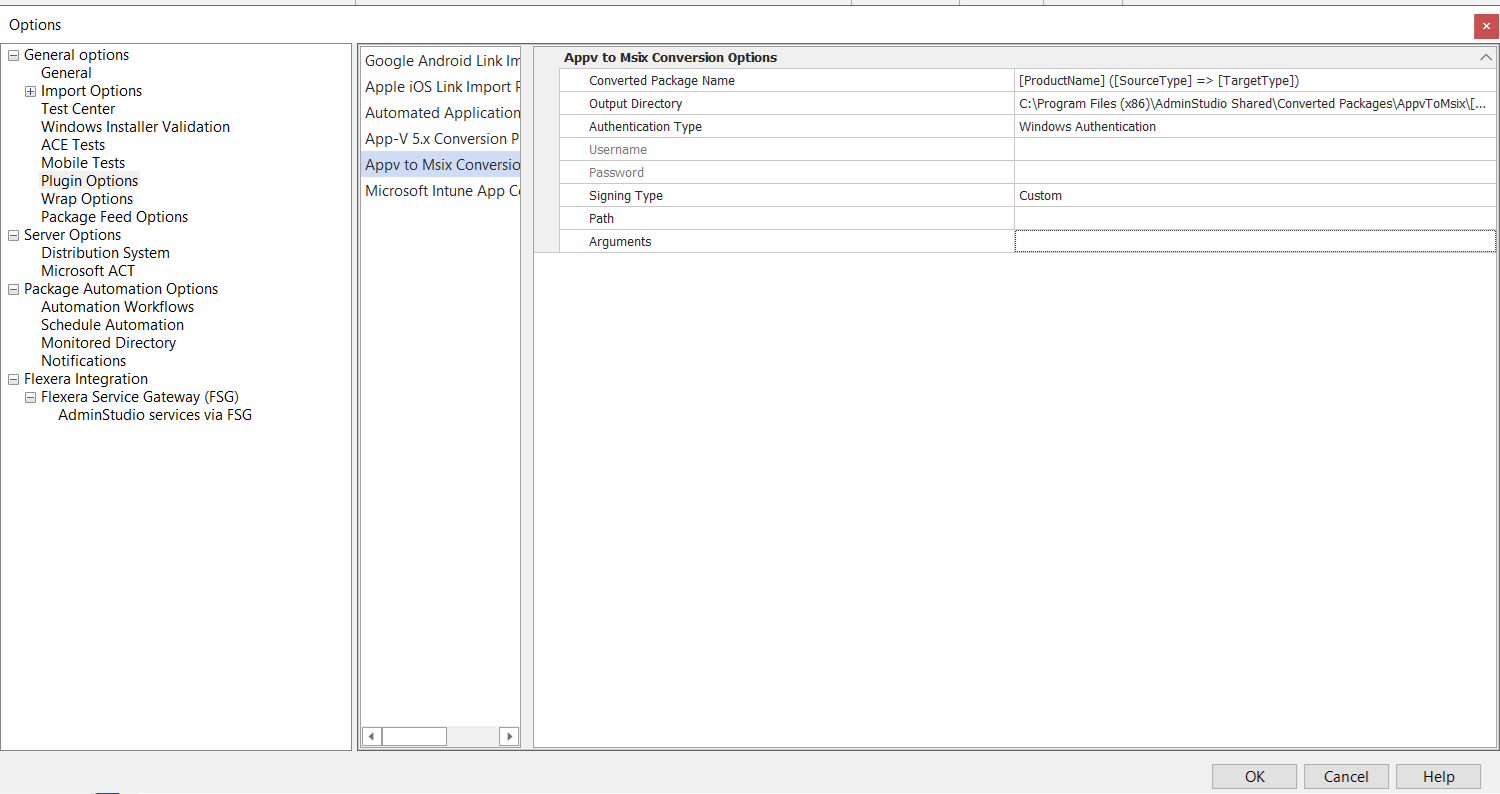Setting App-V to MSIX Conversion Options
AdminStudio 2025 | 29.0 | Application Manager
Prior to using the Conversion Wizard to convert an App-V package to MSIX format, as described in Converting App-V Packages to MSIX Format, you first need to perform the following steps to set MSIX conversion options in Application Manager.
To set App-v to MSIX conversion options:
|
1.
|
In Application Manager, select Options on the Application Catalog menu. The Options dialog box opens. |
|
2.
|
Open the General options > Plugin Options tab. |
|
3.
|
In the middle pane, select Appv to Msix Conversion Plugin. The Appv to Msix Conversion Options are displayed in the right pane. |

|
4.
|
In the Converted Package Name field, enter the format of the converted page name to differentiate it from the converted version of the package from the original version. By default, this field will be populated with: |
[ProductName] ([SourceType] => [TargetType])
|
5.
|
In the Output Directory field, Specify the output folder where you want the converted MSIX packages to be located. By default, the Output Directory is: |
C:\Program Files (x86)\AdminStudio Shared\Converted Packages\AppvToMsix\[Vendor]\[Product Name]\[Version]
Note:Supported placeholders are: Vendor, Product Name, Version, Setup Type, Platform, and Language.
|
6.
|
In the Authentication Type drop down field, choose one of the following: |
|
a.
|
Server Authentication—Choose this option if you want to use server login identification to log into this server. Then enter the appropriate Username and Password. |
|
b.
|
Windows Authentication—Choose this option if you want to use Windows network authentication (your network login ID) to log into this server. |
|
7.
|
In the Signing Type drop down, choose one of the following. |
|
•
|
Standard—Uses this option to digitally sign MSIX packages with a pre-configured certificate. Suitable for most common signing scenarios. |
|
•
|
Custom—Use this option to configure and use a custom signing solution for digitally signing MSIX packages. This is useful for automation scenarios where the standard signing option doesn't meet your requirements. |
If you select Standard, perform the following:
In the Certificate Type drop down, choose one of the following.
|
•
|
Certificate File (.pfx) |
|
•
|
Certificate Location—Specify a path to a valid PFX certificate file. |
|
•
|
Certificate Password—Specify the password for the PFX certificate file. |
|
•
|
Timestamp URL—Specify the valid Time Stamp Server URL. |
|
•
|
Certificate Store Location—In the Certificate Store Location drop down, select either User or Machine |
|
•
|
Certificate Store Name—In the Certificate Store Name drop down, select any one of the store name from the list. |
|
•
|
Certificate Subject—In the Certificate Subject drop down, select respective certificate subject from the list. |
If you select Custom, perform the following:
|
•
|
Path—Specify the location of the signing tool to digitally sign the package. The Path field supports executables .exe, .bat (batch files), .vbs (VBScript), or .ps1 (PowerShell scripts) for performing custom signing of MSIX packages. |
Click the ellipsis (...) button to browse and select the file location.
Example:
<ProgramFilesFolder>\Windows Kits\10\bin\<WinSDKVer>\x86\signtool.exe
|
•
|
Arguments—Specify the required command-line arguments for the SignTool or custom script file. These arguments will be passed at runtime during the signing process. |
Enter the command-line parameters appropriate for the custom signing tool specified in the Path field.
Example:
If Microsoft's built-in SignTool is used as the custom signing tool, you might use the following:
sign /fd SHA256 /f <ProgramFilesFolder>\testCA.pfx /t http://timestamp.digicert.com /p 123 /v "[Filename]"
Note:Use "[Filename]" in the command where the MSIX package path should be inserted during signing. At runtime, "[Filename]" will be automatically replaced with the actual MSIX package path.
For more information, see Custom Signing with HSM Support.
